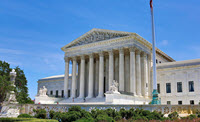
The Senate Banking, Housing, and Urban Affairs Committee on Thursday held a hearing, “Examining Bipartisan Bills to Promote Affordable Housing Access and Safety,” to discuss bipartisan legislation aimed at expanding access to affordable housing generally and improving safety conditions in federally-assisted housing specifically.
- Among the bills considered at the hearing were:
- the HUD Manufactured Housing Modernization Act (S.1804). This bill would confirm for state and local recipients of funding from the Department of Housing and Urban Development (HUD) (such as Community Development Block Grants), that manufactured housing is eligible for public dollars for construction and repair; and
- the Fostering Stable Housing Opportunities Act (H.R. 4300), which advanced unanimously by the House of Representatives’ Financial Services Committee in September. This bill would authorize HUD to allocate Section 8 housing choice vouchers directly to any public housing agency that aims to assist youths aging out of foster care and at risk of losing their housing safety net.
- Mark Yost (CEO, Skyline Champion Corp.) testified on behalf of the Manufactured Housing Institute (“MHI”) in support of S. 1804. He stated that increased construction costs combined with labor shortages render manufactured housing a logical solution to help increase affordable housing options. (Mark Yost Testimony)
- The Roundtable advocates that safe, decent and affordable housing is essential to the well-being of America’s families, communities and businesses. The Roundtable is developing a multi-faceted strategy and is assessing policies such as those that encourage:
- State and local governments to adopt and implement Yes in My Backyard (“YIMBY”) land-use policies to entitle affordable housing projects, such as high-density zoning and expanding by-right multifamily zoned areas;
- Development of low-income and workforce housing units as a priority when the U.S. government disposes under-utilized and surplus federal properties;
- Construction of manufactured housing – the only form of housing regulated by a Federal building code that includes standards for health, safety, and energy efficiency – as a gateway that opens the door for homeownership for millions of families;
- Increased support for HUD’s Section 8 voucher program to assist very low-income, elderly, and disabled Americans to afford housing in the private market; and
- Modernizing the role of Fannie Mae and Freddie Mac through GSE reform, to focus their mission on providing liquidity in mortgage markets geared toward low-income and middle-class home ownership.
- On November 1, Roundtable President and CEO, Jeffrey D. DeBoer, raised these priorities in a housing affordability summit at the White House with HUD Secretary Ben Carson and other industry leaders. DeBoer’s comments followed on the heels of Secretary Carson’s remarks to The Roundtable several days prior at its 2019 Fall Meeting. (Roundtable Weekly, November 1, 2019).
The Roundtable will continue to work with our industry partners, the Administration, and Congress to implement a multifaceted strategy that addresses the nation’s housing affordability crisis.
# # #

